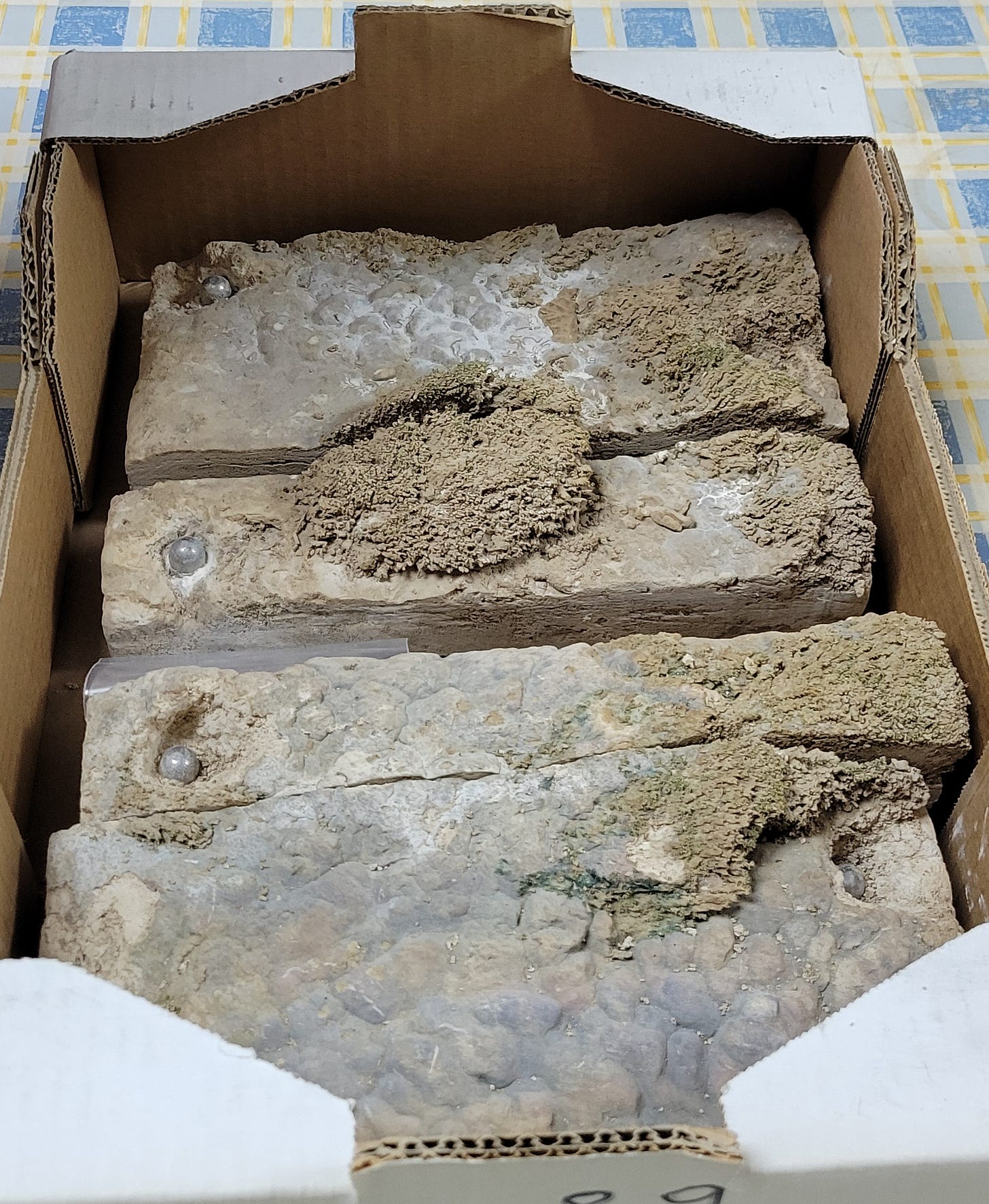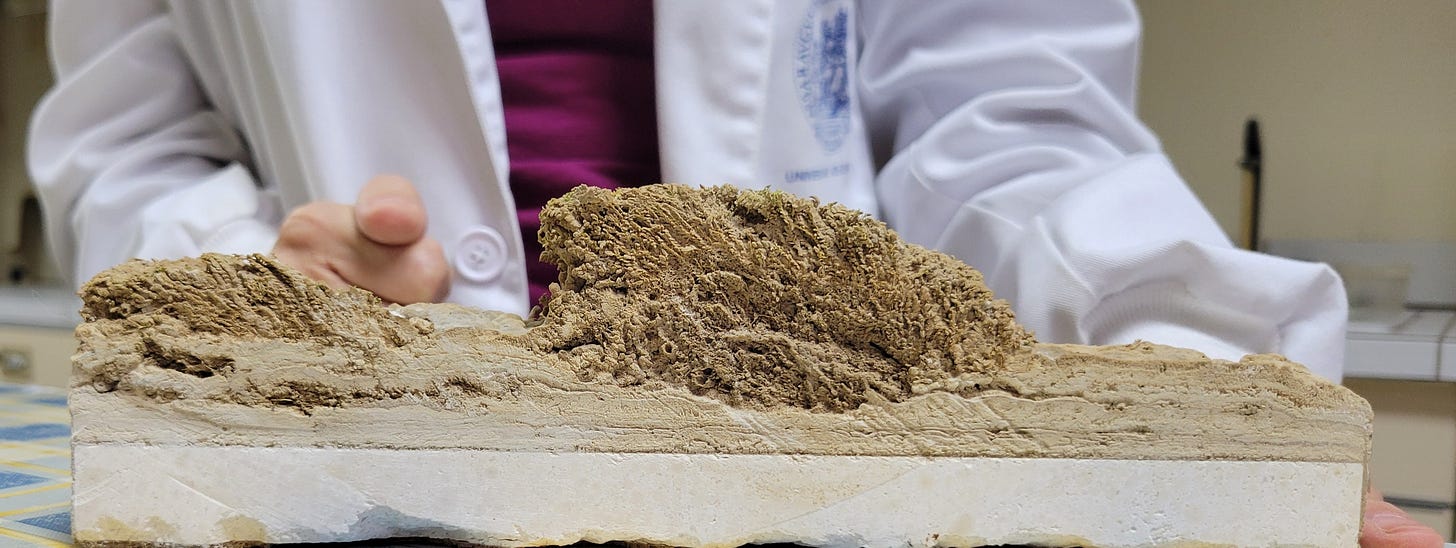In a past post I went into a deep dive on the formation of microbialites, rocks made by microbes. Last week I went into the field with Concepción Arenas-Abad, a profesor at the University of Zaragoza. On our first day it was rainy so we hung out in her lab. It was a day full of deep learning for me (and Lisa!) and developing a friendship that I hope continues well beyond my time in Spain. She is one of the most gracious, kind, and warm scientists I have had the honor of working with. Consider this: Concha literally dropped all of her work for four days to spend it with Lisa and I, taking us into the field and sharing her deep knowledge of microbialites.
How fast can microbes make rock?
Here we have these communities of microscopic organisms. How can they be that important in terms of making rocks, right? I mean, seriously, this seemed counterintuitive to me at first, and I’m a geologist. The more I studied these rocks, though, the more I realized that they are prolific rock-makers. Like seriously prolific. The first time I realized this was in Nevada. Anders Ness, one of my awesome students with whom I worked, and I described a thick sequence of rocks in a slot canyon north of Lake Mead. This is called “measuring a section” and it’s the way that geologists like me describe the detailed changes that happen through a pile of sedimentary layers. Here’s an example of what one of these looks like for a really famous place with lots of sedimentary layers:
We measured about 200 meters of section, about 600 feet, bed-by-bed. It was all limestone and it was nearly all microbialites. Thanks to my amazing esposa, we found some volcanic deposits in the section that allowed us to get actual ages of some of the layers. Without going into too much detail, we were able to estimate that it took about 600,000 years to deposit 200 m of section. That works out to be about 0.3 mm/year, about 0.01 inches/year. Seems really slow, right? But this works out to be something like 300 m per million years, or 900 feet per million. That’s actually pretty fast. What’s more, there was very little evidence of erosion or times of non-deposition in this record. One thing most folks don’t understand is that the sedimentary record has huge gaps in it due to times of erosion and non-deposition. This was, in our view, an almost gap-free record. If you want to see the original article, you can go here (warning: dense academic shit):
But Concha blew my mind…
Microbes making rocks near springs
So Concha studies both modern and ancient microbialites. Today’s story is about the first. There are a number of springs that feed rivers in the Iberian Ranges south of Zaragoza. When the water leaves these springs it is loaded with Calcium and bicarbonate, the main ingredients of calcite (see that earlier post). It is also loaded with carbon dioxide. So when the water come out of the ground, it’s relatively acidic and no calcite gets precipitated out of the water. But as the water mixes with the atmosphere as it flows down its course, it loses some of its carbon dioxide and it becomes more basic. Bam! Calcite starts to precipitation. And, of course, microbes help this along in spades.
Concha got this great idea, borrowed from some Aussie geologists, to insert ceramic plates on the streambed, about the size of an 8x10 photo. They were anchored to the bed and she would come back every few months (end of summer and winter), measure the river’s chemistry, temperature, pH, etc. She would also collect the plates and measure how much “stuff” was deposited on them and install a new, clean plate. She did this for twelve years, some longer! Here’s a photo of Concha and one of those plates:
You can see a close up in the image at the top of this post.
That “stuff” is limestone. That “stuff” is a stromatolite and that “stuff” is a microbialite and it’s rock. It’s hard. That plate has well over 2 inches (5 cm) of limestone on it! And this comes from about a half a year of sitting there on the streambed, because she only picked up the plates at the end of winter and the summer. Remember my growth rates from Nevada? Less than 1 mm/year. Her’s are growing a few powers of ten faster. That’s fast!
Not only microbes, but mosses!

Now we already knew that microbial mats make limestone, but Concha also found that mosses can do some serious calcite-mediated precipitation too. Check out those funky, fuzzy, bushy clumps in the photo above. Here’s what they look like in cross section:

So the thing you need to know here is that these types of limestones that Concha made over the past 20 years or so have a very slim chance of making it into the ancient rock record. This is because they formed on a streambed pretty far upstream. That stream is prone to floods (we saw the effects of the devastating floods that slammed Valencia in late 2024 on these rivers as well). Floods erode sediment and the upstream parts of rivers really never make it into the ancient. They just get eroded away.
BUT…and it’s an important one…
These studies do show us how fast microbes and mosses can assist in the formation of these rocks and their sedimentation rates are out of this world! Furthermore, even though these might not make it to the big show in the rock record, there are plenty of places where they can and do. We’ll see some of those in a later post.
I, personally, think all of this is freaking cool as hell. But some people need to see an economic benefit. Guess what? There is one. The world’s best, sweet crude oil comes from algae (i.e. microbes). Algae is loaded with lipids (fats) and have no cellulose or lignin (the woody parts of plants). Fats break down into waxes, then crude oil, then natural gas. There are important oil reservoirs offshore of Brazil, Angola, and Nigeria that are in ancient lakes that were loaded with microbialites. By developing a better understanding of microbialite formation, we develop a deeper understanding of these oil reservoirs.
They also tell us a lot about the natural environment in which they formed, so they are like clues to past landscapes. When we find them in the rock record, we can say a lot about what the place was like where they formed.
So they might be tiny, but those critters make a ton of rock…
Arenas-Abad, C., Vázquez-Urbez, M., Pardo-Tirapu, G., and Sancho-Marcén, C., 2010, Chapter 3 Fluvial and Associated Carbonate Deposits, in Alonso-Zarza, A.M. and Tanner, L.H. eds., Developments in Sedimentology, Elsevier, Carbonates in Continental Settings: Facies, Environments, and Processes, v. 61, p. 133–175, doi:10.1016/S0070-4571(09)06103-2.







Glad to hear you are excited about travertines! We have tons in NM! Come check them out when you get back!
Okay those tiles are just crazy